Blog
Luxsin X9 Review — Headfonics

James reviews the Luxsin X9, a compact desktop DAC and 6.4W-capable headphone amplifier with an innovative DSP-based approach to sound quality. It is currently priced at $1099.
Disclaimer: I received this sample in exchange for my honest opinion. Headfonics is an independent website with no affiliate links or services. I would like to thank Luxsin Audio for their support.
You can click here to learn more about the solid-state amplifier products previously reviewed on Headfonics.
This post follows our current scoring guidelines, which you can read in more detail here.
In this review, I will cover the new Luxsin X9 desktop integrated DAC and headphone amplifier from a brand that might be unfamiliar to some.
Luxsin is a subsidiary of Zidoo, alongside the well-regarded Eversolo brand known for its mature and robust streaming solutions, such as the DMP-A6 Gen 2 and the recently reviewed Play.
Since Eversolo doesn’t feature headphone outputs, Luxsin carves out a distinct niche with the X9, blending Zidoo’s strong software expertise with hardware innovations.
Beyond its AK4499EX decoding chip, the X9 has advanced features such as discrete R2R resistor arrays for precise volume control, impedance sensing, and plenty of DSP tweaks for headphone users.
The product page on Luxsin’s website doesn’t fully capture the integration and practicality of these features, which is what I aim to do in this review.
In this review, I will also put the X9 through its paces, testing it against some of my benchmark gear such as the FiiO K17 and the RME ADI-2 Pro. Read on to find out how the X9 performs and compares.
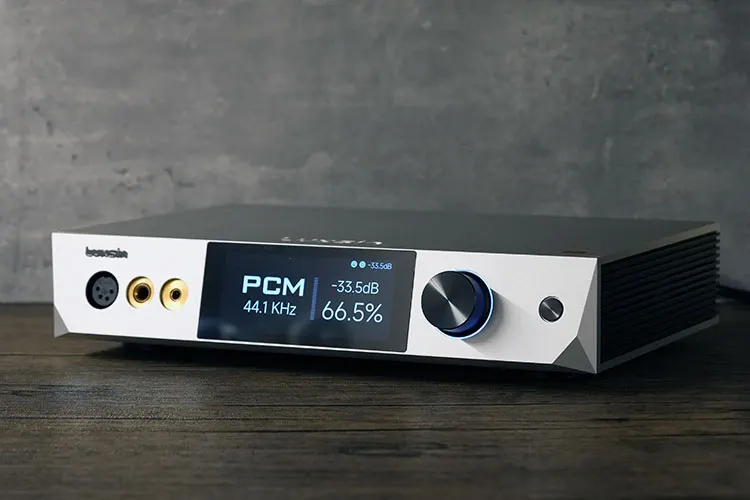

Features
The Luxsin X9 is built on a 6.4W into 16Ω capable fully balanced architecture, leveraging an AKM 4191+4499EX DAC to decode audio files up to DSD512 and 32-bit/768kHz PCM.
To optimize decoding and amplification, a linear power supply is used with separate digital and analog signal paths, utilizing what Luxsin calls a “star-shaped” power distribution system.
This design achieves an ultra-low 40nV ripple in the power supply, enhancing noise control and expanding the dynamic range.
For further refinement, Luxsin uses OPA1612 opamps as a buffer to provide a stable reference voltage to the DAC, minimizing noise and distortion while maximizing dynamic range.
The X9 delivers exceptional performance metrics with its headphone outputs, including a dynamic range and SNR exceeding 128dB, which is beyond the human ear’s threshold. The THD+N measurement, which is less than 0.00016% is also decent.


Design
The Luxsin X9 features a sleek, tilted front panel with faceted corners, giving it a modern yet distinctive aesthetic.
Its 4-inch laminated TFT touchscreen offers sufficient pixel density and allows smooth gesture navigation for tasks like adjusting I/O settings or switching between cool VU visualizers.
The design stands out with bold, contrasting colors, and the angled screen proves practical, allowing easy setting adjustments even when standing.
The logo on top carries a retro vibe, echoing 80s and 90s design, while the UI is well programmed to be intuitive and allows users to reach the desired function by minimal steps, and has many different visualizing effects that you can swipe between.
Weighing nearly 4kg, the X9 feels very sturdy and free from resonance. The physical layout is thoughtfully organized on both the front and back, and the actual device looks better than the rendering on the website, feeling more premium and rigid.


I/O
The Luxsin X9 offers versatile connectivity. On the rear panel, you’ll find XLR pre-amp outputs, RCA outputs, and dual subwoofer RCA output ports for 2.2 setups, a less common feature on desktop amplifiers/pre-amps.
This allows users to adjust the subwoofer cutoff frequency while simultaneously applying a low-cut filter for the speakers, enhancing setup flexibility.
For inputs, the X9 supports USB-B, USB-C, Bluetooth, RCA, coaxial, optical, and HDMI ARC/eARC, with seamless on-screen switching between these sources.
Another standout feature is the dual trigger ports on the back, enabling automatic on/off control for connected devices in the setup chain.


Impedance Detection
The Luxsin X9 includes an advanced impedance monitoring feature that detects the impedance of connected headphones and recommends the optimal gain level.
This enhances efficiency, reduces distortion, and improves feedback control in the amplification section, resulting in superior noise reduction.
For instance, when connecting my Sennheiser HD 800s, the X9’s screen displays an animation that measures the impedance before automatically switching to high gain. Note that this feature is exclusive to 6.3mm and 4.4mm connections.
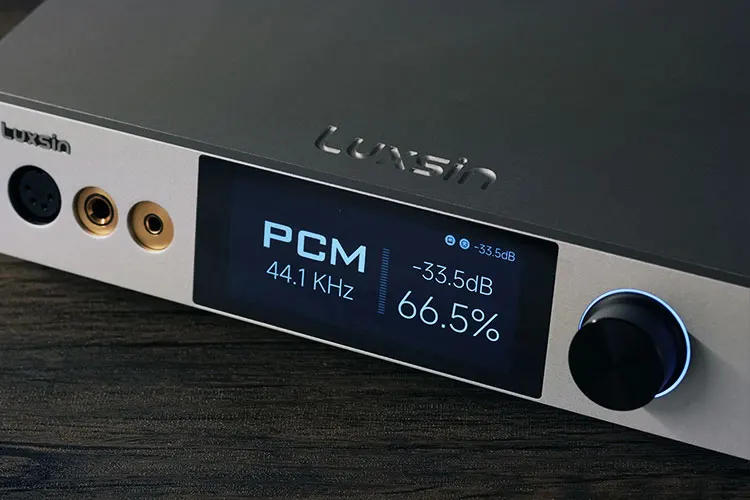

Controls
When turning the volume dial on the Luxsin X9, it displays “R2R” on screen, signifying its precise, discrete resistor pairs for each volume step in 0.5dB increments.
A satisfying clicking sound accompanies each step, likely from internal relay components, adding a tactile charm to the experience.
The fully balanced design further reduces distortion and noise compared to traditional potentiometers, achieving an impressive 0.1dB left/right channel balance accuracy.
This premium feature makes the X9 ideal for listeners in quiet environments or those using highly sensitive equipment, ensuring consistent performance even at lower volumes.
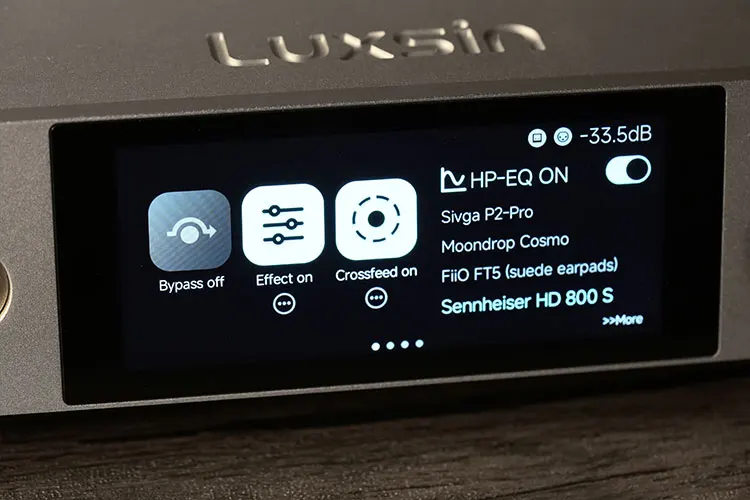

HP-EQ Custom Profiles
The Luxsin X9, powered by the AKM 7739 DSP chipset, comes with 2,500 preloaded headphone profiles with hardware-based EQ adjustments.
You can input your headphone model to search and to save a shortlist of frequently used headphones, enabling instant profile switching for tailored audio experiences.
What the official introduction materials don’t highlight is the ability to select from multiple target curves, alongside configurable options like crossfeed, filters, and other DSP settings that can be configured on screen and on other devices. You can also select combinations of these or toggle them on and off to compare their impact.
This intuitive yet powerful configuration panel stands out as one of the most impressive for headphone amplifiers, offering both flexibility and ease of use.
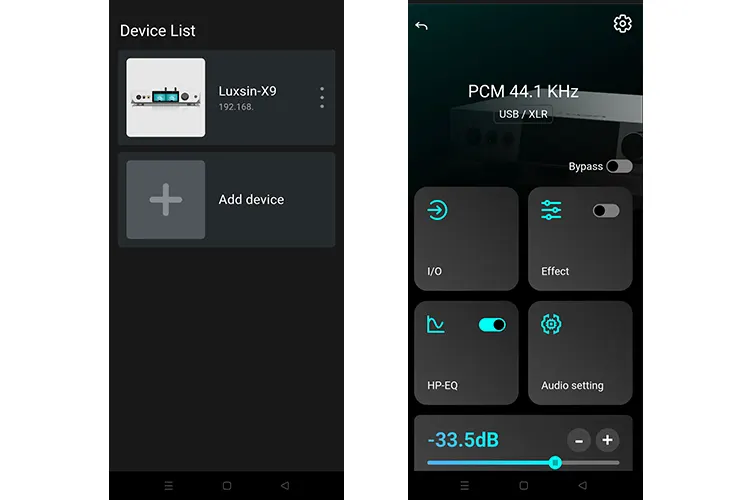

Connectivity
Bluetooth
The Luxsin X9 incorporates a QCC5125 Bluetooth 5.0 shipset, supporting AAC and SBC decoding. While wired connections remains the go-to for optimal audio quality, Bluetooth is a convenient bonus for streaming directly from a phone.
I am not sure why LDAC and aptX are missing, as QCC5125 does support aptX upwards, which could help benefit the output quality. One factor might be licensing costs for aptX.
Compared to USB playback of the same file, the Bluetooth output has a slightly softer top end with less definition but maintains an overall engaging and well-rounded performance.
WiFi
For configuring the DSP features, you can connect your phone, PC, or tablet to the X9 over the same WiFi network.
In addition to a dedicated control app, the X9 offers a web-based control panel, accessible via a link found on the device’s “About” page.
The interface visualizes tuning curves, allowing you to customize PMEQ settings with ease, and is very straightforward and user-friendly, with a minimal learning curve.
USB-DAC
The Luxsin X9 features three USB ports, with the USB-A port dedicated exclusively to firmware updates.
Both the USB-B and USB Type-C ports support connections to USB audio sources, compatible with Windows 10, Windows 11, Android, and iOS devices.
These ports enable high-resolution audio playback, supporting up to Stereo DSD512 and PCM 768kHz/32-bit decoding without requiring driver installation.
Packaging & Accessories
The X9 comes in a well-padded packaging, which is essential for this rather heavy device. Inside, you will find manuals, a power cord, a Bluetooth remote, as well as a USB-B and Type-C OTG cable.
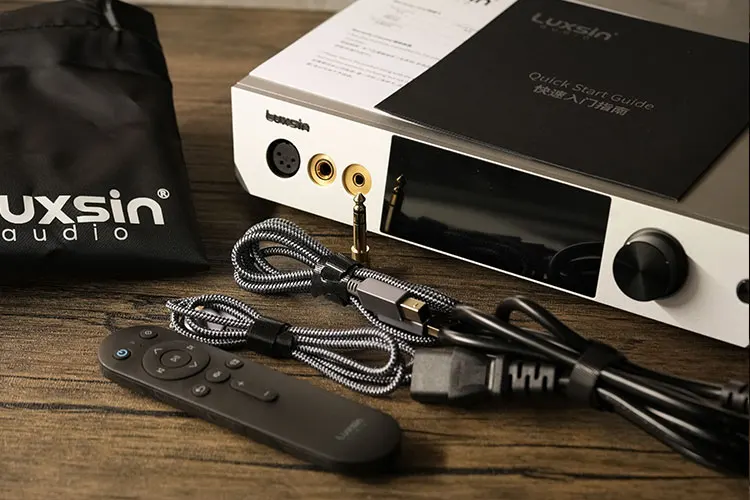

Sound Impressions
The following sound impressions of the Luxsin S9 were completed after a week of burn-in, with testing conducted using the Sennheiser HD 800s and various planar headphones, including the MOONDROP COSMO, VENUS, FiiO FT7, and the SIVGA P2 Pro.
Summary
The Luxsin X9 combines a handful of practical DSP features with high precision audio components, delivering decent distortion control and an engaging listening experience.
Straight out of the box, it offers a rather neutral-flat response, characterized by a noise-free, pitch-black background, a strong sense of control throughout the whole frequency spectrum, and impactful bass with clean decay.
But clearly, this unit has a lot more to do with DSP, which does sound more engaging, including the crossfeed feature.
The decoding quality is decent on USB input, with micro-details well-captured, and the bass kicks solid and deep, particularly with planar magnetic headphones.
With sensitive IEMs, it also sounds quite dynamic and natural, maintaining a clean, agile, and controlled signature across different gears tested.
To me, the X9 successfully demonstrates how advanced digital processing practically helps achieve better perceived sound qualities, at the same time not sounding fatiguing or too altered in tone.
The headphone EQ profiles allow impedance skews and various issues to be compensated well, and this is the most user-friendly approach for a DSP-reinforced device I have tried thus far.


Timbre
On USB connection, the X9 sounds quite neutral and gently rolled off in its 4.4mm output under bypass mode.
Testing with the SIVGA P2 Pro, it demonstrates great control, definitive power, and agility in bass, without being overly aggressive in displaying its power. The bass impacts are tight, firm, with a clean decay.
The treble offers satisfactory power, sounding quite clean without being overly lifted for transparency, allowing room for various equalization profiles, and avoiding sounding clinical.
The subs are clearly audible but not overly boosted, keeping the entire spectrum swift and layered, and sounds smooth yet textured with high BPM EDMs and guitar riffs that heavily use electronic bass instruments.
Once DSP is applied, the tuning changes dramatically, enhancing the output’s dynamics and giving the vocal line more authority while suppressing resonance spikes.
The digital filters are also helpful for fine-tuning brightness, and generally, they smooth out the spikes and dips for better linearity along the spectrum.
Using the HD 800s to listen to the Firebird Suite and Mars with intense, big drums, the X9 maintains speed and control even with stronger current draws. The combo presents large orchestral works with good tension and power.
Once DSP is engaged, the two ends are boosted for more vividness and stronger dynamics, and the mids are imaged fuller, which enhances separation.
With sensitive, cleaner-sounding gear, there can be a slight digital sheen when listening to songs with a cool tone. Nevertheless, the DSP options are quick fixes that help improve layering, dynamics, and articulation.
The X9 aims for a reference-style, harsh-free tuning. It appears to work best with loads that have moderate to higher impedance, and at lower gain levels, it may sound somewhat polite in attack, while higher gain strengthens the perceived power.
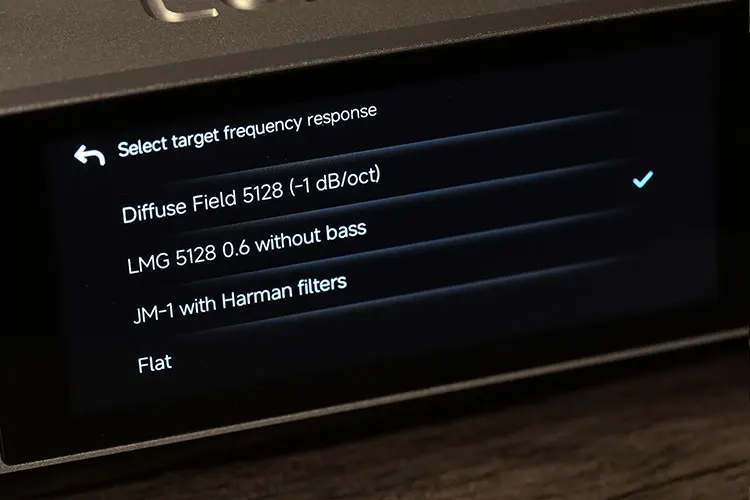

Staging & Dynamics
The Luxsin X9 offers an expansive stage with its smooth, slightly laid-back tuning. There is a gentle roll-off in the stock tuning, which helps to capture satisfactory air but without harshness, and both ends sound sufficiently extended.
The stereo image isn’t very distinct on stock settings. With DSP applied to some target curves, it helps outline the vocal line better.
A little bit more on vocal positioning, you can check the cross-feed function to improve the perception of a centered, out-of-head image. Normally, I don’t find cross-feed very natural, but it’s well-implemented here, with several profiles you can switch between that don’t sound hollow.
In general, the X9 offers the ambiance of an opera house where the listener is properly distanced from the stage, and weaker voices are positioned a bit laid back, whereas powerful virtuosos cut through more distinctively.
Instruments are well-separated, and with crossfeed on, you might feel them spreading wider across the perceived stage.
With planars, the bass feels deeper, more textured, and more accurate, like in a damped room, while dynamic headphones sound bolder for bass instruments.
Click on page 2 below for my recommended pairings and selected comparisons.













